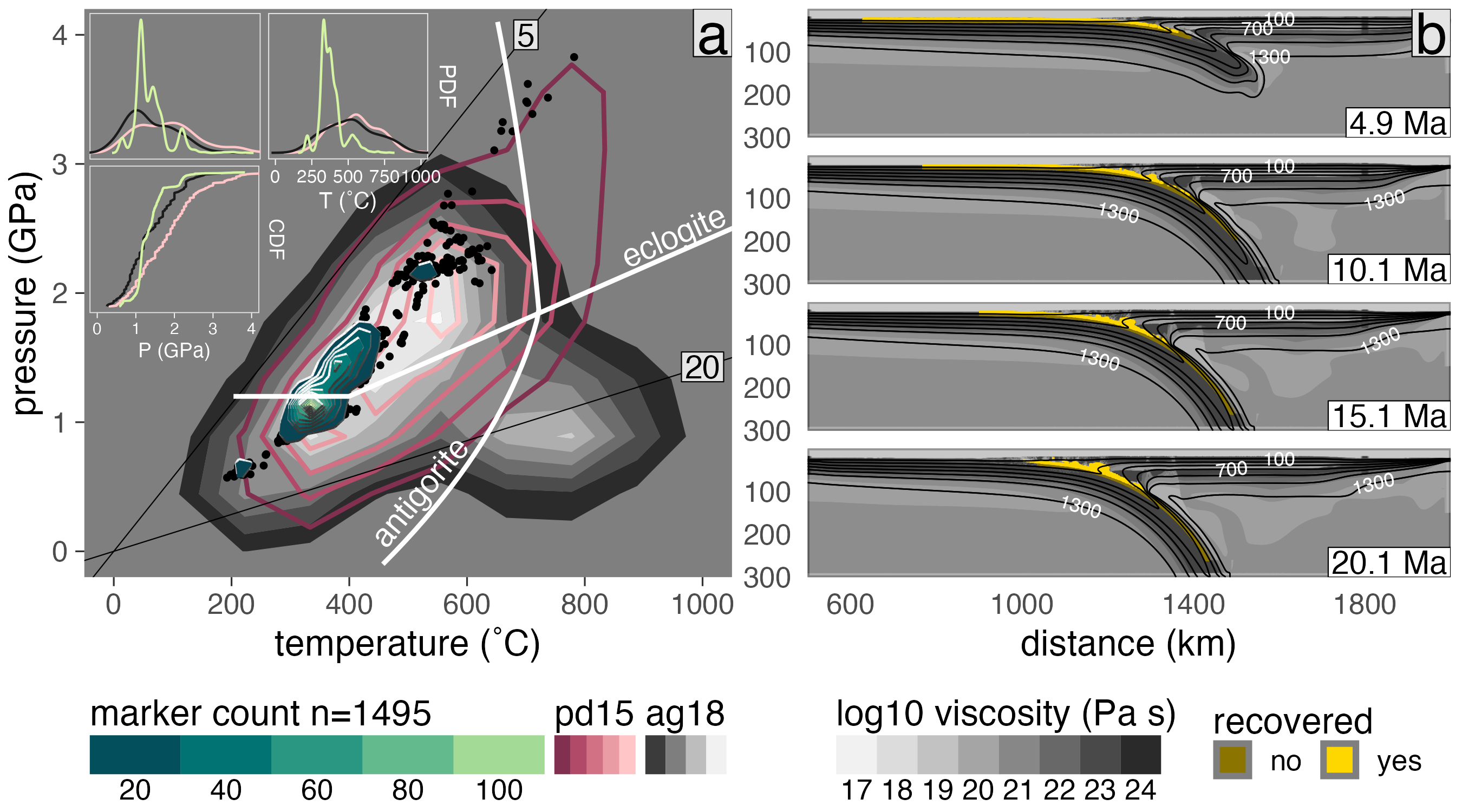Computing rates and distributions of rock recovery in subduction zones
This work investigates where, and how many, rocks get detached from subducting oceanic plates beneath convergent margins. Over one-million numerical markers (representing rock fragments) from 64 numerical experiments were traced and classified as recovered, or not recovered, using a bespoke classification algorithm we wrote. Our results indicate that rocks are recovered from discrete depths, rather than continuously along the subduction interface.
The manuscript was published in Geochemistry, Geophysics, Geosystems on May 18, 2023. You can find the article here.

Figure: Summary of marker recovery for model cda62. (a) Pressure-temperature diagram showing the frequency of recovered markers (black points and green Tanaka contours) in comparison with the pd15 (solid red contours) and ag18 (filled gray contours) data sets. Thin lines are thermal gradients labeled in °C/km. Reaction boundaries for eclogitization of oceanic crust and antigorite dehydration are from Ito and Kennedy (1971) and Schmidt and Poli (1998), respectively. Marker counts (Tanaka contours) are computed across a 100 × 100 grid (0.04 GPa × 10°C). (insets) Probability distribution functions (top insets) and cumulative distribution functions (bottom inset) comparing P and T distributions between numerical experiments (green lines) and natural samples (pink lines: pd15, black lines: ag18). (b) Visualization of log viscosity in the model domain showing the major modes of marker recovery along a relatively thick subduction interface that tapers near the viscous coupling depth.
Coauthors:
- Matthew Kohn (Boise State University)
- Taras Gerya (ETH Zürich)
Acknowledgement
We gratefully acknowledge high-performance computing support from the Borah compute cluster (https://doi.org/10.18122/oit/3/boisestate) provided by Boise State University’s Research Computing Department. We thank two anonymous reviewers who provided thoughtful feedback that greatly improved the manuscript. We also thank Whitney Behr for her editorial handling. This work was supported by the National Science Foundation Grant OISE 1545903 to M. Kohn, S. Penniston-Dorland, and M. Feineman.
Open Research
All data, code, and relevant information for reproducing this work can be found at https://github.com/buchanankerswell/kerswell_et_al_marx, and at https://doi.org/10.17605/OSF.IO/3EMWF, the official Open Science Framework data repository (Kerswell et al., 2023). All code is MIT Licensed and free for use and distribution (see license details).
Abstract
Bodies of rock that are detached (recovered) from subducting oceanic plates, and exhumed to Earth’s surface, become invaluable records of the mechanical and chemical processing of rock along subduction interfaces. Exposures of interface rocks with high-pressure (HP) mineral assemblages provide insights into the nature of rock recovery, yet various inconsistencies arise when directly comparing the rock record with numerical simulations of subduction. Constraining recovery rates and depths from the rock record presents a major challenge because small sample sizes of HP rocks reduce statistical power. As an alternative approach, this study implements a classification algorithm to identify rock recovery in numerical simulations of oceanic-continental convergence. Over one million markers are classified from 64 simulations representing a large range of subduction zones. Recovery pressures (depths) correlate strongly with convergence velocity and moderately with oceanic plate age, while slab-top thermal gradients correlate strongly with oceanic plate age and upper-plate thickness. Recovery rates strongly correlate with upper-plate thickness, yet show no correlation with convergence velocity or oceanic plate age. Likewise, pressure-temperature (PT) distributions of recovered markers vary among numerical experiments and generally show deviations from the rock record that cannot be explained by petrologic uncertainties alone. For example, a significant gap in marker recovery is found near 2 GPa and 550°C, coinciding with the highest frequencies of exhumed HP rocks. Explanations for such a gap in marker recovery include numerical modeling uncertainties, selective sampling of exhumed HP rocks, or natural geodynamic factors not accounted for in numerical experiments.